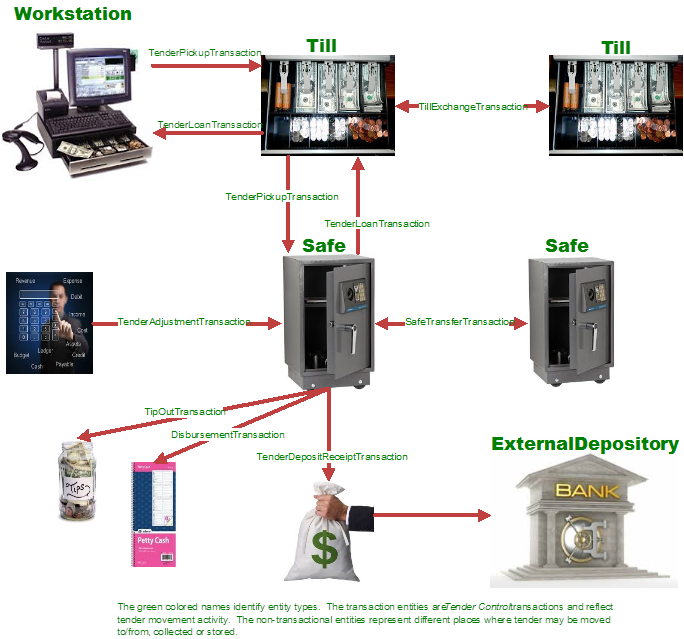Subject Area Concepts This subject area contains the entity types involved in tracking the movement of tender throughout a store and the tender settlement transactions that serve as key points of tender accountability and reconciliation. The subject area is extended to incorporate store safe and external depository tender repository types in addition to tills. Tender MovementThe diagram illustrates how tender movement between tender repositories works in a retail store context and is the basis for the entity model for this subject area. Figure 84 - Store-level Tender Repositories and Tender Movement
Tender SettlementIn addition to tracking tender movement, the Logical 03160 subject area contains entities used to reconcile and settle tender amounts accumulated in the different tender repositories. Each tender repository represents a retailer audit and control point. Each tender repository settlement period ending balance must reflect the opening tender amount plus all tender received minus all tender paid out or transferred out (through a tender pickup or safe transfer). Furthermore tender accountability is enforced for each distinctly type of tender. This means that cash, checks, debit/credit card, electronic benefit transfers, payment on account and all other retail sales debits representing an exchange of tender for sold merchandise or services must be balanced. A settlement period is the time interval bounded by two consecutive tender settlement transactions. There are different settlement periods for tills, safes and tender depositories since each has its own tender settlement transactions. Each tender repository settlement is a summary of transaction-level tender values aggregated over the period of time between till settlement transactions. The TillTender entity has cumulative value attributes that keep a running sum for the current till settlement period. The entry of a TillTenderSettlementTransaction signifies the end of the settlement period and triggers the following steps: •The TillTender summary attribute values are posted to TillSettlementTenderDetail rows (one for each tender type). The TillSettlementTenderDetail is a dependent entity of the TillSettlementTransaction. It is providing line item detail for the till settlement transaction; •Once posted, the TillTender entity's ending balance is moved into the beginning balance; •The TillTender entity's cumulative attributes are zeroed out and the transaction-level accumulation starts for a new till settlement period. The "historical" memorialization of the till settlement is captured and identified as the TillSettlementTransaction which inherits a date and time from its ControlTransaction -> Transaction ancestors. This same pattern applies to the Safe and ExternalDepository tender repository types. Because each must be settled individually, each has its own distinct tender settlement period. Also, like the till, each has its own current tender settlement period accumulation entity. Till Settlement DocumentThe aforementioned entities handle tender reconciliation and settlement. In addition, for tills only, a TillSettlementDocument entity is provided to carry summary attributes for non-tender totals including sales, returns, discounts, taxes as well as a number of transaction counts. The TillSettlementDocument provides an all-in-one overview of till activity for a tender settlement period. Unlike TillSettlementTransaction and its child TillSettlementTenderDetail, the TillSettlementDocument does not break its totals out by tender type. Rather, it provides a till settlement summary of tender-related debits, credits and transaction counts. It provides a convenient way for retailers to capture summary totals for sales audit and transaction financial accounting purposes. |
